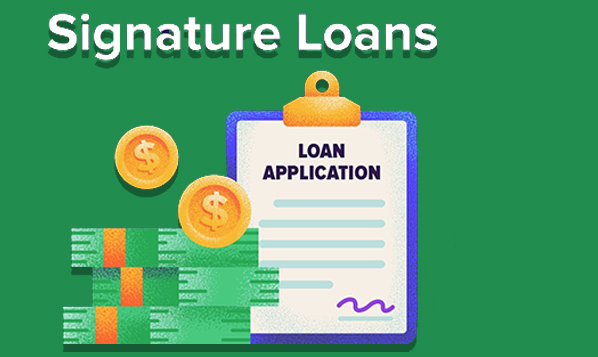A few different kinds of personal loans provide an option when money is tight. The best terms are found in a signature loan, which has more favorable rates than other unsecured debt and only needs your signature as collateral. However, these loans do have drawbacks, just like any other financial product. In addition to fees, some lenders might charge you a high interest rate.

A signature loan, sometimes referred to as a “good faith loan” or a “character loan,” is a kind of personal loan that banks and other lending institutions provide. The borrower’s signature and promise to repay the loan are all necessary, without any tangible collateral like a house or car title. Generally, a borrower can use a signature loan for any purpose they choose.
Because there is no collateral, interest rates may be higher than for other types of credit, but they may also be lower than for other unsecured credit, like credit cards. In this article, we will discuss the major advantages and disadvantages of a signature loan to help you decide if it suits you.
How Does Signature Loan Work
Generally, a lender considers two things when deciding whether to approve a signature loan: a strong credit history and enough income to cover the loan’s repayment. A co-signer may occasionally be required by the lender. However, they will only be contacted if the primary lender fails to make payments.
One kind of unsecured term loan is a signature loan. Unsecured loans, unlike home mortgages and auto loans, are not backed by any tangible collateral. The term refers to the loan’s amortization over a specified duration and its equal monthly installment repayment schedule.
How Much Can You Borrow On a Signature Loan
Generally, you can make money up to $50,000 with a signature loan, though the precise limits will differ depending on the lender. Lenders will sometimes offer up to $100,000 for signature loans. An applicant’s credit score and income are among the factors that a lender considers when determining how much to lend them.
In addition, signature loan amounts will not be as high as other types of loans. This is because there is no collateral being provided to secure this type of loan should you default on payments.
Best Uses of a Signature Loan
You can use a signature loan for various kinds of purposes due to their flexibility. In addition, the following are among the best uses of a signature loan:
- Debt consolidation.
- Home Improvement.
- Medical expenses.
- Expenses for emergencies.
- Purchasing a car from a private seller.
Advantages and Disadvantages of Signature Loan
Signature loans come with benefits and drawbacks. It’s crucial to take both into account when evaluating your financing options.
Advantages
- No collateral is needed: No collateral is needed because signature loans are unsecured, so if you can’t repay the loan, you won’t have to worry about losing important possessions like your home or car.
- Lower interest rates than credit cards: Signature loans often offer lower annual percentage rates (APRs) than credit cards, especially for borrowers with good or excellent credit.
- Fast financial access: Because there isn’t an inspection or appraisal like there is with secured loans, approval is quicker. After the loan closes, funds are typically available a few business days later, and occasionally even hours later.
- Flexible use: You can fund large purchases or consolidate debt with this loan, among other uses.
Disadvantages
- Higher interest rates than secured loans: Interest rates are typically higher for unsecured loans than for secured loans because there is no collateral.
- Requires good credit: To be eligible for a signature loan with favorable conditions, you usually need good credit. Lower credit score borrowers might pay higher interest rates or have more difficulty acquiring granted.
How to Get a Signature Loan
If you believe that obtaining a signature loan is the best thing that would meet your needs, proceed as follows:
Check your credit report
Your credit score could be reduced if any information is incorrect or missing. Verify the accuracy of your credit reports before applying for a loan. Every week, you can visit AnnualCreditReport.com to obtain one free credit report. File a dispute with each credit reporting agency that identifies any errors you find in credit reporting.
Prequalify with multiple lenders
As many lenders as you can prequalify will allow you to compare your loan options. Once you submit your application, a lender will perform a soft credit check to review your credit, which has no impact on your credit score. You will receive estimated rates and terms if you are prequalified.
Fill out and submit a loan application
After deciding on a lender, fill out the loan application. You’ll likely be required to provide financial and personal data, including bank statements, your name, social security number (SSN), employment, and income.
Accept the funds after signing the loan agreement
If your application is accepted, you will receive a signed loan agreement from the lender. If you agree with the terms, carefully read them over and sign. Within a few business days, the lender should then deposit the money into your bank account.
Pay back the loan
Make sure you pay back the loan you signed on time. Missing payments could result in late fees and damaged credit, which would make it more difficult for you to get loans in the future. To remember when things are due, set up auto-pay or make use of a spreadsheet.
Final Thought
One kind of personal loan that just needs your promise to repay the loan amount is a signature loan. These days, consumers with higher credit scores are essentially the only ones who can purchase them, whereas in the past they were mainly made for those with bad credit. Signature loans have higher interest rates than secured loans, and not all banks offer them.

